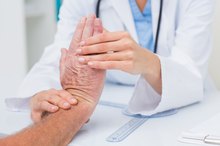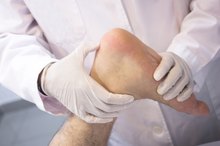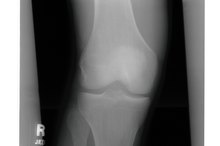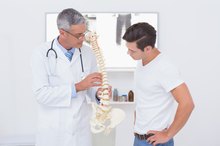Like all parts of your body, your bones are living tissue. Your bones undergo remodeling throughout life wherein old bone is removed and replaced by new bone. Bone diseases affect normal growth, development or remodeling leading to weakness and/or deformity. These diseases affect children and adults and occur due to genetic abnormalities, nutritional deficiencies, hormonal disorders, infections and other conditions.
If you are experiencing serious medical symptoms, seek emergency treatment immediately.
Osteoporosis
Your bones normally reach their maximum mass at age 25 to 30 after which they gradually lose density. Osteoporosis is characterized by an abnormal loss of bone mass and deterioration of normal bone structure. This causes bone fragility and an increased risk for fractures. According to a November 2014 study published in the "Journal of Bone and Mineral Research," 10.3 percent of US adults aged 50 or older have osteoporosis and 43.9 percent have low bone mass 23. Osteoporosis rarely causes symptoms and is often diagnosed only after a fracture has occurred. Regular exercise and adequate calcium and vitamin D intake reduce the risk for osteoporosis. Medications called bisphosphonates help preserve bone mass in people with osteoporosis.
- Your bones normally reach their maximum mass at age 25 to 30 after which they gradually lose density.
- Osteoporosis rarely causes symptoms and is often diagnosed only after a fracture has occurred.
Paget Disease of Bone
Bone Eating Diseases
Learn More
Paget disease of bone (PDB) is the second most common bone remodeling disease after osteoporosis. PDB affects approximately 1 to 2 percent of white adults aged 55 or older, according to an April 2009 review article published in "Therapeutic Advances in Musculoskeletal Disease." The condition tends to run in families and rarely occurs in people of African or Asian descent 4. With PDB, bone resorption and subsequent new bone formation occur at an accelerated rate. This leads to soft, enlarged bones. The spine, pelvis, skull and leg bones are most commonly affected. Although many people with PDB have no symptoms, bone deformities can lead to joint pain, bowing of the legs, headaches and hearing loss. Treatment may include bisphosphonates, orthotic devices and surgery to correct severe deformities.
- Paget disease of bone (PDB) is the second most common bone remodeling disease after osteoporosis.
- With PDB, bone resorption and subsequent new bone formation occur at an accelerated rate.
Osteomyelitis
Osteomyelitis refers to a bacterial bone infection, which can either be acute or chronic. An estimated 50,000 cases of osteomyelitis occur annually in the US, according to Epocrates 7. Symptoms may include localized bone pain, tenderness, redness and swelling as well as possible fever and chills. Antibiotics are the primary treatment. In some cases, surgery is need to remove infected bone tissue.
- Osteomyelitis refers to a bacterial bone infection, which can either be acute or chronic.
Osteogenesis Imperfecta
Bone Deterioration Diseases
Learn More
Osteogenesis imperfecta is an inherited disease characterized by brittle bones that fracture easily. With each of the 8 types of osteogenesis imperfecta, a defective gene leads to impaired production of collagen, a structural protein necessary for normal bone formation. Osteogenesis imperfecta is typically diagnosed in childhood and affects an estimated 20,000 to 50,000 people in the US, according to the National Institutes of Health 6. The signs and symptoms of osteogenesis imperfecta vary and may include:
- short stature
- loose joints
- muscle weakness
- spinal curvature
- brittle teeth
- bone deformity
- barrel-shaped chest
- hearing loss
- a blue or gray tint to the whites of the eyes
- Osteogenesis imperfecta is an inherited disease characterized by brittle bones that fracture easily.
- Osteogenesis imperfecta is typically diagnosed in childhood and affects an estimated 20,000 to 50,000 people.
Osteonecrosis
With osteonecrosis, loss of blood supply causes death of bone tissue. The disease most commonly affects the head of the thighbone, or femoral head. The shoulder, knee, wrist or ankle bones can also be affected. An estimated 20,000 to 30,000 people in the US are diagnosed with osteonecrosis of the femoral head each year, as reported in a September 2015 article in the "World Journal of Orthpedics." Most cases of osteonecrosis occur due to bone trauma, such as a hip fracture or dislocation 9. People with this condition typically develop gradually progressive bone pain. Small areas of osteonecrosis may heal without treatment. For larger bone lesions, treatment may include medication, physical therapy and/or surgery. Total joint replacement is performed if the bone collapses.
Legg-Calvé-Perthes disease is a rare childhood bone disorder similar to osteonecrosis of the femoral head in adults. With this condition, however, the bone typically regenerates in 6 to 24 months.
- With osteonecrosis, loss of blood supply causes death of bone tissue.
- Legg-Calvé-Perthes disease is a rare childhood bone disorder similar to osteonecrosis of the femoral head in adults.
Bone Tumors
Most tumors that arise in the bones are noncancerous. The number of people affected by these tumors is unknown as they often cause no symptoms and remain undetected. Cancerous bone tumors are relatively uncommon with an estimated 3,260 new cases per year, according to a 2017 American Cancer Society report 12. The most common bone cancer is osteosarcoma, which primarily affects children, adolescents and young adults. Metastatic bone cancer, with which cancer from another area of the body spreads to one or more bones, occurs far more frequently. Several of the most common types of cancer often spread to the bones, including lung, breast, prostate and colon cancer. Bone pain and tenderness are common symptoms. Fractures may occur when normal bone is replaced by cancer cells. Treatment for bone tumors depends on the type, size, location and other factors.
- Most tumors that arise in the bones are noncancerous.
- Metastatic bone cancer, with which cancer from another area of the body spreads to one or more bones, occurs far more frequently.
Rickets and Osteomalacia
Osteomalacia and rickets are characterized by defective mineralization of the bones, which cause them to be soft and fragile. Rickets affects children and osteomalacia affects adults. These diseases can be caused by a nutritional vitamin D deficiency, or impaired intestinal absorption or metabolism of the vitamin. Children with rickets typically experience stunted growth and bowing of the leg bones. Symptoms common with both rickets and osteomalacia include widespread bone pain and tenderness, and muscle weakness. Treatment typically includes vitamin D supplementation and possibly other therapies, depending on the underlying cause.
Reviewed and revised by: Tina M. St. John, M.D.
- Osteomalacia and rickets are characterized by defective mineralization of the bones, which cause them to be soft and fragile.
Related Articles
References
- Merck Manual Professional Version: Osteoporosis
- Journal of Bone and Mineral Research: The Recent Prevalence of Osteoporosis and Low Bone Mass in the United States Based on Bone Mineral Density at the Femoral Neck or Lumbar Spine
- Bone Health and Osteoporosis: A Report of the Surgeon General; Office of the Surgeon General (US)
- Therapeutic Advances in Musculoskeletal Disease: Paget's Disease of Bone: A Review of Epidemiology, Pathophysiology and Management
- Principles and Practice of Endocrinology and Metabolism, 3rd Edition; Kenneth L. Becker
- NIH Osteoporosis and Related Bone Diseases National Resource Center: Osteogenesis Imperfecta Overview
- Epocrates: Osteomyelitis Epidemiology
- American Family Physician: Diagnosis and Management of Osteomyelitis
- World Journal of Orthopedics: Current Concepts on Osteonecrosis of the Femoral Head
- Professional Guide to Diseases, 9th Edition; Lippincott Williams & Wilkins
- Pituitary: Incidence and Prevalence of Acromegaly in a Large US Health Plan Database
- American Cancer Society: Cancer Facts and Figures 2017
- American Cancer Society. Key statistics about bone cancer. Updated January 8, 2020.
- Beary JF and Chines AA. Osteogenesis imperfecta: Clinical features and diagnosis. UpToDate. Updated May 3, 2019.
- Johns Hopkins Medicine. Skeletal dysplasia.
- Neumann PE, Gest TR. How many bones? Every bone in my body. Clinical Anatomy. 2020;33(2):187-191. doi:10.1002/ca.23425
- Biga LM, Dawson S, Harwell A, et al. Chapter 6. Bone tissue and the skeletal system. In: Anatomy & Physiology. Published 2020.
- NIH Osteoporosis and Related Bone Diseases. Osteoporosis: Peak bone mass in women. Updated October 2018.
- NIH Osteoporosis and Related Bone Diseases ~ National Resource Center. Osteoporosis overview. Updated October 2018.
- Harvard Medical School. Osteopenia: When you have weak bones, but not osteoporosis. Updated July 6, 2020.
- Medline Plus. Rickets. Updated August 5, 2018.
- Cleveland Clinic. Osteomalacia. Updated August 14, 2018.
- American Cancer Society. Key statistics about bone cancer. Updated January 8, 2020.
- Konieczny MR, Senyurt H, Krauspe R. Epidemiology of adolescent idiopathic scoliosis. J Child Orthop. 2013;7(1):3-9. doi:10.1007/s11832-012-0457-4
- Centers for Disease Control and Prevention. Arthritis. Updated October 1, 2020.
- Medline Plus. Paget's disease of bone. Updated August 12, 2020.
- American College of Rheumatology. Osteonecrosis. Updated March 2019.
- Cleveland Clinic. Osteomyelitis. Updated November 18, 2017.
- Beary JF and Chines AA. Osteogenesis imperfecta: Clinical features and diagnosis. Updated May 3, 2019.
- Krakow D. Skeletal dysplasias. Clin Perinatol. 2015;42(2):301-viii. doi:10.1016/j.clp.2015.03.003
- Johns Hopkins Medicine. Skeletal dysplasia.
- NIH Osteoporosis and Related Bone Diseases ~ National Resource Center. Smoking and bone health. Updated December 2018.
- Panday K, Gona A, Humphrey MB. Medication-induced osteoporosis: screening and treatment strategies. Ther Adv Musculoskelet Dis. 2014;6(5):185-202. doi:10.1177/1759720X14546350
- Medline Plus. Aging changes in hormone production. Updated October 8, 2020.
- Cauley JA. Defining ethnic and racial differences in osteoporosis and fragility fractures. Clin Orthop Relat Res. 2011;469(7):1891-1899. doi:10.1007/s11999-011-1863-5
- Singer FR. Paget’s disease of bone. In: Endotext. Feingold KR, Anawalt B, Boyce A, et al., editors. Updated January 4, 2020.
Writer Bio
Noreen Kassem is a hospital doctor and a medical writer. Her articles have been featured in "Women's Health," "Nutrition News," "Check Up" and "Alive Magazine." Kassem also covers travel, books, fitness, nutrition, cooking and green living.









